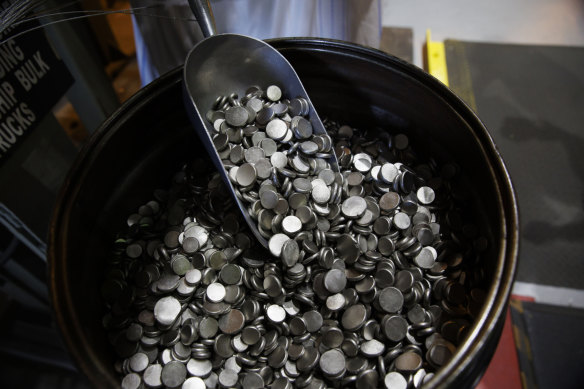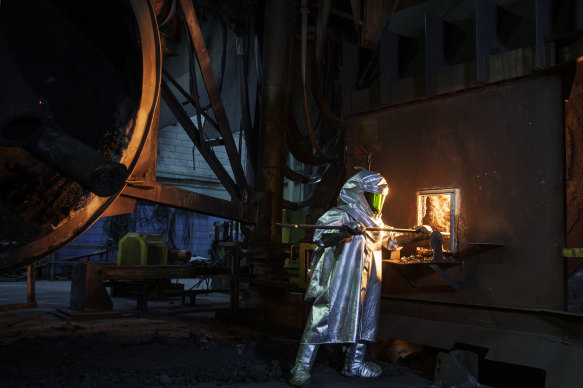Metal mystery: The inside story of a bizarre $856m scandal
It’s one of the more bizarre episodes, even for a commodities sector studded with not dissimilar scandals. How did one of the world’s biggest and most sophisticated commodities traders end up losing up to $US577 million ($856 million) while supposedly financing 25,000 tonnes of nickel cargoes?
The answer is, at face value, straightforward.

Trafigura, which rivals Glencore as one of the world’s largest commodity traders (and which shares parentage, as both groups were started by former Marc Rich + Co traders 30 years ago), though it was financing valuable cargoes of nickel but says it subsequently discovered that the more than 1000 containers supposedly carrying the metal were actually full of material worth a fraction of nickel’s value.
Trafigura was doing, albeit on a large scale, something quite commonplace in the commodity trading business. It was buying the nickel from another trader with an agreement that it would subsequently be sold back to them, or to a third party nominated by them, or into the open market.
In effect, Trafigura was acting simply as a lender, leveraging a lower cost of funds than the counterparty to collect an interest margin on the transaction.
In this instance the counterparty was a 43-year-old India businessman, Prateek Gupta, with whom Trafigura had a business relationship dating back to 2015.
In court filings this month Trafigura has accused Gupta of a “systematic fraud” that was only uncovered when it, and the four third parties to whom it had sold $US94 million of the “nickel” began checking the containers and discovered that they actually contained carbon steel – which sells for less than $US1000 a tonne versus nickel’s $US25,000-plus – and other low-grade metals.
The first warning signs of something suspect came late last year when Citigroup, which had been providing Trafigura with some of the financing for the cargoes, yanked its credit lines, leaving Trafigura to fund them by itself from its own resources.
Citi had apparently become concerned that Gupta’s companies had stopped entering new “buyback” deals, the time it was taking to complete the existing transactions. Trafigura itself was also getting nervous because the companies had stopped making payments to it.
That caused the trading house to start checking the containers – as yet it has only been able to inspect about 120 of the more than 1000 containers – where it discovered that the metal in them definitely wasn’t nickel.
How could a vastly experienced trader allow itself to be scammed by such a simple scheme, particularly when the counterparty had a somewhat chequered history and many banks and traders wouldn’t deal with him?
Gupta, who claimed to be recovering from a heart attack, had allegedly tried to dissuade Trafigura from proceeding with the inspection but subsequently confirmed that none of the containers contained high-grade nickel. He offered a payment plan, spread over several years and supported by collateral, to repay Trafigura and buy back the 93 cargoes involved. He made a number of attempts to raise funds by issuing bonds from his TMT Metals Group to finance the repayments.
Gupta blamed a business partner in India for the contents of the containers but also suggested that the lack of nickel in them was to avoid a ban on transporting Russian nickel, even though there is no sanction on Russian nickel.
It may or may not be relevant to what occurred that the nickel price was quite volatile last year, spiking last February after Russia invaded Ukraine, soaring when the London Metals Market was nearly broken when the price of nickel traded on the exchange broke through $US100,000 a tonne and then falling back to trade around a $US20,000 to $US25,000 a tonne range through the middle of the year. The current price is just under $US25,000 a tonne.
Trafigura, which agreed to buy back the $US94 million of supposed nickel it had sold to third parties, ultimately decided (as more of the containers were opened by the third parties and its customers were threatening legal action) to initiate its own court action. Earlier this month it sought, successfully, to have $US625 million of Gupta and Gupta companies’ assets frozen.

There is an obvious question that flows from the saga. How could a vastly experienced trader allow itself to be allegedly scammed by such a simple scheme, particularly when the counterparty had a somewhat chequered history and many banks and traders wouldn’t deal with him? In India, the police raided a number of locations connected with him last year after the State Bank of India has accused him and his mother of a “criminal conspiracy.”
The answer lies in the nature of the transactions. They are paper-based, reliant on shipping documents and warehouse records and therefore inherently vulnerable to document fraud. They can be struck when the cargoes involved are already in transit, making inspection impractical.
Trafigura isn’t the first to be on the wrong side of an apparently fraudulent transactions.
Notoriously, a trader in 2020 thought they were acquiring $US36 million of copper only to discover their containers were full of painted rocks.
There have been similar scams in nickel and aluminium, with the traders finding they’d provided credit for cargoes that they later discovered were either fictitious or only a fraction of the value they’d been pledged. Others have “their” cargoes have been used as collateral for multiple transactions.
While Glencore has claimed that that its controls are such that a similar incident to Trafigura’s couldn’t happen to it, it is clear that traders will have to conduct far more due diligence on their counterparties and be more discriminating about who they are prepared to deal with.
There are also efforts to develop and adopt electronic transferable records, which might create greater transparency around the movement of cargoes and of their financing and help reduce the incidence of document fraud. It would seem that some application of the blockchain technologies that underpin crypto assets might have potential.
In any event, the fact that it was Trafigura at the centre of the scandal rather than some less-credentialed firm, will be a wake-up call for other traders and their customers and those banks that help finance trades.
The Business Briefing newsletter delivers major stories, exclusive coverage and expert opinion. Sign up to get it every weekday morning.
Most Viewed in Business
Source: Thanks smh.com